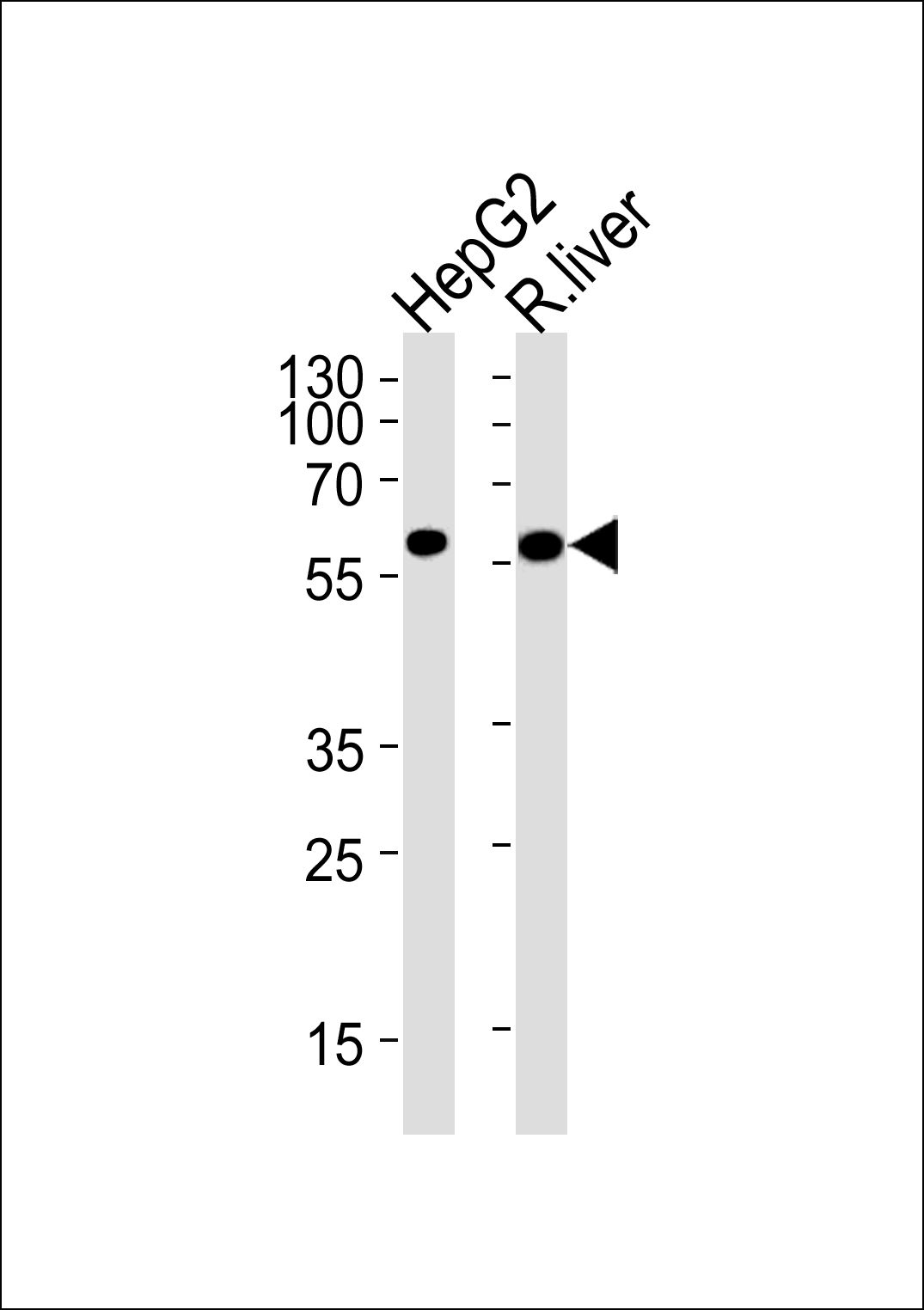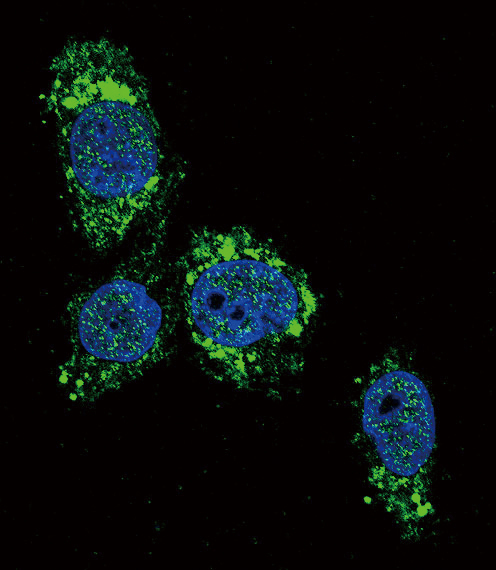GCK Antibody (N-term)
Purified Rabbit Polyclonal Antibody (Pab)
- 产品详情
- 实验流程
- 背景知识
Application
| IF, IHC-P, WB, E |
|---|---|
| Primary Accession | P35557 |
| Reactivity | Human, Rat, Mouse |
| Host | Rabbit |
| Clonality | Polyclonal |
| Isotype | Rabbit IgG |
| Calculated MW | 52191 Da |
| Antigen Region | 1-30 aa |
| Gene ID | 2645 |
|---|---|
| Other Names | Glucokinase, Hexokinase type IV, HK IV, Hexokinase-4, HK4, Hexokinase-D, GCK |
| Target/Specificity | This GCK antibody is generated from rabbits immunized with a KLH conjugated synthetic peptide between 1-30 amino acids from the N-terminal region of human GCK. |
| Dilution | IF~~1:10~50 IHC-P~~1:100~500 WB~~1:1000 E~~Use at an assay dependent concentration. |
| Format | Purified polyclonal antibody supplied in PBS with 0.09% (W/V) sodium azide. This antibody is prepared by Saturated Ammonium Sulfate (SAS) precipitation followed by dialysis against PBS. |
| Storage | Maintain refrigerated at 2-8°C for up to 2 weeks. For long term storage store at -20°C in small aliquots to prevent freeze-thaw cycles. |
| Precautions | GCK Antibody (N-term) is for research use only and not for use in diagnostic or therapeutic procedures. |
| Name | GCK {ECO:0000303|PubMed:17573900, ECO:0000312|HGNC:HGNC:4195} |
|---|---|
| Function | Catalyzes the phosphorylation of hexose, such as D-glucose, D-fructose and D-mannose, to hexose 6-phosphate (D-glucose 6-phosphate, D-fructose 6-phosphate and D-mannose 6-phosphate, respectively) (PubMed:11916951, PubMed:15277402, PubMed:17082186, PubMed:18322640, PubMed:19146401, PubMed:25015100, PubMed:7742312, PubMed:8325892). Compared to other hexokinases, has a weak affinity for D-glucose, and is effective only when glucose is abundant (By similarity). Mainly expressed in pancreatic beta cells and the liver and constitutes a rate-limiting step in glucose metabolism in these tissues (PubMed:11916951, PubMed:15277402, PubMed:18322640, PubMed:25015100, PubMed:8325892). Since insulin secretion parallels glucose metabolism and the low glucose affinity of GCK ensures that it can change its enzymatic activity within the physiological range of glucose concentrations, GCK acts as a glucose sensor in the pancreatic beta cell (By similarity). In pancreas, plays an important role in modulating insulin secretion (By similarity). In liver, helps to facilitate the uptake and conversion of glucose by acting as an insulin-sensitive determinant of hepatic glucose usage (By similarity). Required to provide D-glucose 6-phosphate for the synthesis of glycogen (PubMed:8878425). Mediates the initial step of glycolysis by catalyzing phosphorylation of D-glucose to D-glucose 6-phosphate (PubMed:7742312). |
| Cellular Location | Cytoplasm. Nucleus. Mitochondrion {ECO:0000250|UniProtKB:P17712}. Note=Under low glucose concentrations, GCK associates with GCKR and the inactive complex is recruited to the hepatocyte nucleus. |
For Research Use Only. Not For Use In Diagnostic Procedures.
Provided below are standard protocols that you may find useful for product applications.
BACKGROUND
Hexokinases phosphorylate glucose to produce glucose-6-phosphate, thus committing glucose to the glycolytic pathway. Alternative splicing of the gene for GCK results in three tissue-specific forms of glucokinase, one found in pancreatic islet beta cells and two found in liver. The protein localizes to the outer membrane of mitochondria. In contrast to other forms of hexokinase, this enzyme is not inhibited by its product glucose-6-phosphate but remains active while glucose is abundant. Mutations in the gene have been associated with non-insulin dependent diabetes mellitus (NIDDM), also called maturity onset diabetes of the young, type 2 (MODY2); mutations have also been associated with persistent hyperinsulinemic hypoglycemia of infancy (PHHI).
REFERENCES
Gloyn, A.L., et al., Diabetes 52(9):2433-2440 (2003).
Pruhova, S., et al., Diabetologia 46(2):291-295 (2003).
Rizzo, M.A., et al., J. Biol. Chem. 277(37):34168-34175 (2002).
Cao, H., et al., Hum. Mutat. 20(6):478-479 (2002).
Barrio, R., et al., J. Clin. Endocrinol. Metab. 87(6):2532-2539 (2002).
终于等到您。ABCEPTA(百远生物)抗体产品。
点击下方“我要评价 ”按钮提交您的反馈信息,您的反馈和评价是我们最宝贵的财富之一,
我们将在1-3个工作日内处理您的反馈信息。
如有疑问,联系:0512-88856768 tech-china@abcepta.com.























 癌症的基本特征包括细胞增殖、血管生成、迁移、凋亡逃避机制和细胞永生等。找到癌症发生过程中这些通路的关键标记物和对应的抗体用于检测至关重要。
癌症的基本特征包括细胞增殖、血管生成、迁移、凋亡逃避机制和细胞永生等。找到癌症发生过程中这些通路的关键标记物和对应的抗体用于检测至关重要。 为您推荐一个泛素化位点预测神器——泛素化分析工具,可以为您的蛋白的泛素化位点作出预测和评分。
为您推荐一个泛素化位点预测神器——泛素化分析工具,可以为您的蛋白的泛素化位点作出预测和评分。 细胞自噬受体图形绘图工具为你的蛋白的细胞受体结合位点作出预测和评分,识别结合到自噬通路中的蛋白是非常重要的,便于让我们理解自噬在正常生理、病理过程中的作用,如发育、细胞分化、神经退化性疾病、压力条件下、感染和癌症。
细胞自噬受体图形绘图工具为你的蛋白的细胞受体结合位点作出预测和评分,识别结合到自噬通路中的蛋白是非常重要的,便于让我们理解自噬在正常生理、病理过程中的作用,如发育、细胞分化、神经退化性疾病、压力条件下、感染和癌症。








